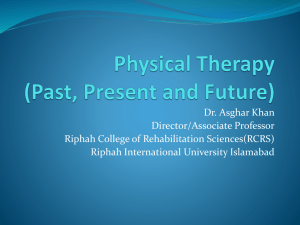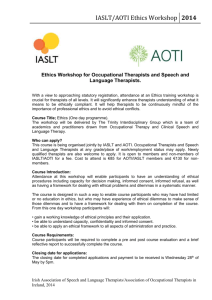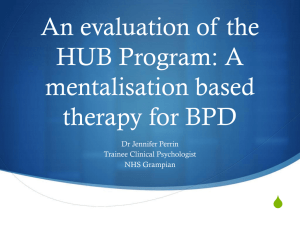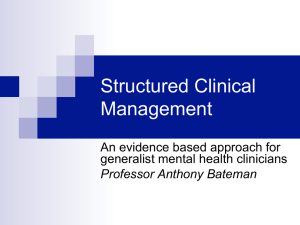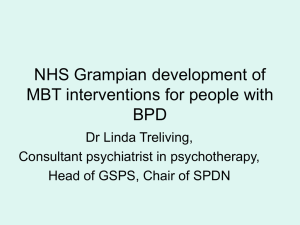Haringey PD service
advertisement
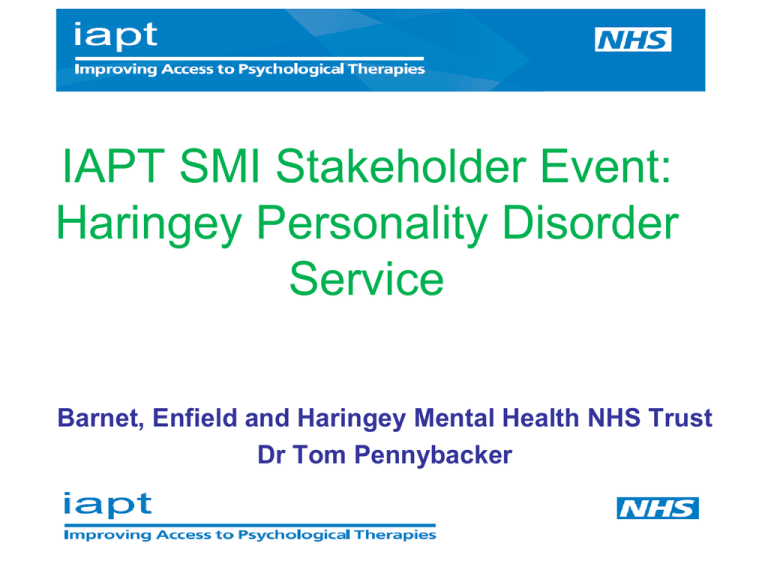
IAPT SMI Stakeholder Event: Haringey Personality Disorder Service Barnet, Enfield and Haringey Mental Health NHS Trust Dr Tom Pennybacker Halliwick Unit Tottenham Haringey The Team The Team What do we do? • Specialist assessment and treatment for people with personality disorder • Team based in local psychiatric services with clear referral pathways from primary and secondary care • Nurse-led liaison service • Introductory group (i-MBT) • Treatment program: Mentalisation Based Treatment (MBT) or Structured Clinical Management (SCM) Guiding principles Organisational support at all levels • Explicit theoretical approach • Structured care and therapist supervision • Long-term psychological interventions (typically 18 months) • Treatment and service is data driven How do we do it? • Mentalisation is the capacity to understand oneself and others in terms of mental states • Sense of self, constructive social interaction, mutuality in relationships, sense of personal security • We are all vulnerable to collapses in our mentalising ability, people with personality disorder especially so • Aim of treatment is to increase the person’s capacity to recover and retain mentalising Treatment vectors in re-establishing mentalizing in borderline personality disorder ImplicitAutomatic Impression Controlled driven Appearance Inference Mental interior focused Certainty emotion Doubt of of cognition Cognitive agent:attitude propositions Imitative frontoparietal mirror neurone system ExplicitControlled Emotional contagion Autonomy Mental exterior focused Affective self:affect state propositions Belief-desire MPFC/ACC inhibitory system Service Practicalities • Standardised assessment (SCID) with identification of severity to determine treatment pathway: MBT or SCM • Introductory group (3 months) leading to structured treatment program with regular consultant-led CPA reviews • Active service user group combined with Patient Experience feedback and Quality Assurance system at Trust management level Predictive Recovery by Axis II Pathology Assessment Refer elsewhere Introductory Group (i-MBT) SCM If 2 or less Axis II diagnoses MBT If 2 or more Axis II diagnoses MBT+ Comorbid Drug use/Alcohol/ED Data collection • Focus of current developments in service • IAPT minimum data set • Patient Owned Database - POD • Historic and current data Percent with Clinical Episode (Attempted Suicide, Self-harmed, or were Hospitalized in Last Six Months) N=62 2011-2012 MBT Percent with Incident 120 . 100 80 60 40 20 0 Baseline Six Months Twelve Months Eighteen Months Percent with Clinical Episode (Attempted Suicide, Self-harmed, or were Hospitalized in Last Six Months) N=74 2011-2012 SCM Percent with Incident 120 100 80 60 40 20 0 Baseline Six Months Twelve Months Eighteen Months Routine data collection – why? • It’s good! • Patients in trials do better than patients with same treatment given in general services • Impact of individual therapists Impact of individual therapists in routine practice Okiishi et al. 2006 (J Clin Psychol 62:9, 1157) • 6,499 patients seen by 71 therapists • therapists had to see at least 15 clients (average 92) • Mean number of sessions: 8.7 • Equivalent clients in terms of disturbance & presentation • Recovery curves monitored Clients of Some Therapists Improve Faster or Slower Than Others Session number Outcomes for Best and Worst Performing Therapists recovered improved deteriorated top 10% therapists 22.4% 21.5% 5.2% bottom 10% therapists 10.6% 17.4% 10.5% Incidence of Harmful Effects • estimates are that 5-10% of therapy clients deteriorate • across all orientations, client groups, modalities • in RCTs of ‘empirically supported treatments’ • rates higher in active treatment than in control groups – NIMH reanalysis13/162 (8%) deteriorated, all in active treatments • therapists tend to be poor at: – predicting who will do badly – recognising failing therapies MBT introductory group data BDI 63 BDI Score (n) 54 45 36 27 18 9 0 Beginning Middle Time Point End Global Severity Score (n) SCL-90 5 4.5 4 3.5 3 2.5 2 1.5 1 0.5 0 Beginning Middle Time Point End Grouped data on POD WSAS 27 24 21 18 15 12 9 6 3 0 40 35 WSAS Score (n) PHQ-9 Score (n) PHQ-9 30 25 20 15 10 5 1 2 3 4 5 6 7 0 8 1 Week 2 3 5 6 7 8 Week EuroQol VAS MOAS 100 90 80 70 60 50 40 30 20 10 0 40 35 Series1 MAOS Score (n) VAS Score (n) 4 30 25 20 15 10 5 0 1 2 3 4 Week 5 6 7 1 2 3 4 Week 5 6 Individual data on POD WSAS 27 24 21 18 15 12 9 6 3 0 40 35 WSAS Score (n) PHQ-9 Score (n) PHQ-9 30 25 20 15 10 5 0 1 2 3 4 5 6 7 8 1 2 3 Week 5 6 7 8 Week EuroQol VAS MOAS 100 90 80 70 60 50 40 30 20 10 0 40 35 MAOS score (n) VAS Score (n) 4 30 25 20 15 10 5 0 1 2 3 4 5 Week 6 7 8 1 2 3 Week 4 5 Next Steps • Comparative severity data • Site visits: starting 16th April – BMJ Experience day – Future dates: 9th May, 13th June, 11th July – Further dates will be arranged according to demand • Regional days with PD commissioning tool PD Service Commissioning Tool • Organisational requirements • commitment, management support • Service framework • clinical pathway, multiagency agreement • Treatment framework • defined programmes, coherence, structure • Quality monitoring • therapist competences, adherence, supervision, outcome monitoring Regional meetings – for whom? • Commissioners, managers, clinicians, service users • Local completion of commissioning tool • Identify and map organisational and service requirements • Links with local service user groups • Benchmarking local services • Define principles of clinical treatments for people with PD • Quality document • Introduce generic clinical skills for treatment of PD in mental health teams The End Thank You

